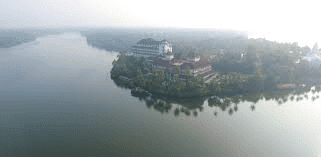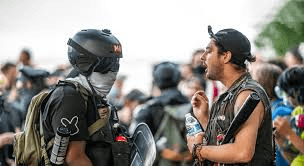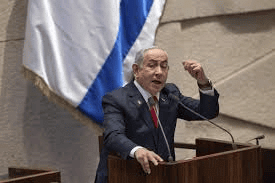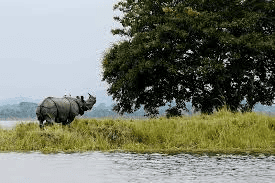UPSC Daily Current Affairs: 23rd November 2024 | Current Affairs & Hindu Analysis: Daily, Weekly & Monthly PDF Download
GS3/Environment
Cold Wave
Source: The Hindu

Why in News?
Days after a notable drop in night temperatures across Telangana, a public advisory regarding cold wave conditions has been issued. This advisory has been released by the National Programme on Climate Change and Human Health (NPCCHH), which is part of the Ministry of Health and Family Welfare. It pertains to Telangana and 16 other states and Union Territories, focusing on the cold wave conditions.
The term cold wave refers to a significant decrease in temperature at a specific location compared to the normal climatological values. According to the Indian Meteorological Department, a cold wave is declared when the minimum temperature falls to 10°C or below for plains and 0°C or lower for hilly regions, with a negative deviation from the normal day temperature ranging from 4.5 to 6.4°C. If this negative departure exceeds 6.4°C, it is categorized as a severe cold wave, indicating that day temperatures are crucial in defining cold wave conditions.
- Furthermore, in plains, a cold wave is noted when the minimum temperature is 4°C or less, while a severe cold wave occurs when it drops to 2°C or below.
- Coastal regions experience cold waves when minimum temperatures reach 15°C or lower, accompanied by a negative departure from the minimum of 4.5°C.
- The advisory emphasizes that the cold wave season spans from November to March, with December and January experiencing the highest frequency of extreme cold events.
The states and Union Territories identified as the 'Core Cold Wave Zone' include:
- Telangana
- Punjab
- Himachal Pradesh
- Uttarakhand
- Jammu and Kashmir
- Ladakh
- Delhi
- Haryana
- Rajasthan
- Uttar Pradesh
- Gujarat
- Madhya Pradesh
- Chhattisgarh
- Bihar
- Jharkhand
- West Bengal
- Odisha
Certain demographic groups are particularly vulnerable to the effects of cold waves, including:
- The homeless
- The elderly
- Economically disadvantaged individuals
- Pregnant and lactating women
- Children
- Outdoor workers and farmers
The advisory warns that prolonged exposure to cold temperatures can lead to severe health problems, such as:
- Hypothermia
- Frostbite
- Non-freezing cold injuries, like Immersion Foot, which is caused by extended exposure to cold and wet conditions
GS3/Environment
Ashtamudi Lake
Source:The Hindu
Why in News?
A recent incident of fish kill in Ashtamudi Lake has highlighted the critical challenges posed by sewage contamination, plastic pollution, encroachments, and uncontrolled weed growth that threaten the ecosystem of this vital lake.
About Ashtamudi Lake:
- Ashtamudi Lake is recognized as a Ramsar wetland situated in the Kollam district of Kerala.
- The name "Ashtamudi" translates to "Eight braids" in Malayalam, referring to the lake's palm-shaped topography characterized by multiple branches.
- This lake is named Ashtamudi due to its eight 'arms' or channels.
- It is the second largest lake in Kerala, which drains into the sea via the Neendakara estuary.
- The Kallada River serves as the primary source of water for Ashtamudi Lake.
Historical Significance:
- The lake holds historical importance dating back to the 14th century when its surroundings were crucial in connecting the ancient city of Quilon to global trade routes.
- Historical accounts from Moroccan explorer Ibn Battuta emphasize Quilon as a significant trading hub along the banks of Ashtamudi Lake during ancient times.
Biodiversity:
- The region is home to various species of marshy mangroves, including two endangered species: Syzygium travancoricum and Calamus rotang.
GS2/Governance
Understanding the Changing Face of Extremist Violence
Source:The Hindu
 Why in news?
Why in news?
The ongoing conflicts in Ukraine and the Israel-Hamas situation have overshadowed various global instances of violence, particularly those linked to extremist groups. This diversion of attention from changing patterns of extremist violence is concerning, as it could have serious future implications. Understanding these developments is crucial for maintaining global stability.
An Overview of Shifting Trends in Extremism
- A RAND study indicates that domestic terrorism and violent extremism are constantly evolving, necessitating law enforcement to adapt accordingly.
- While the study is U.S.-focused, its insights hold global significance.
- Extremist groups, irrespective of their ideological basis, thrive on societal weaknesses, highlighting the need for vigilance from both governments and communities.
Post-Independence India and the Left-Wing Challenge
- Early Communist Movements: Tebhaga and Telangana
- The Tebhaga Movement in the 1940s aimed to reduce landlords' crop shares, advocating for farmers to retain two-thirds of their production.
- This movement was significant among the rural poor but faced harsh suppression, curtailing its revolutionary goals.
- The Telangana uprising, led by the Communist Party of India, was a radical revolt against oppressive landlords, seeking land redistribution and the abolition of exploitative practices.
- The Naxalite Movement: A Persistent Challenge
- By the late 1960s, the Naxalite Movement emerged, rooted in radical Maoist ideology aiming to overthrow the state through armed struggle.
- Unlike earlier movements, the Naxalites emphasized violent class warfare, targeting government entities and perceived enemies of the working class.
- The Role of Ideological Appeal
- The endurance of left-wing extremism in India is linked to its ideological appeal, which continues to resonate with marginalized groups.
- Promises of land reform, social justice, and equality draw support from those left behind by mainstream policies.
- Addressing root issues like poverty, unemployment, and systemic corruption is vital to prevent the revival of such movements.
- Lessons for the Present
- India’s experience with left-wing extremism suggests a multifaceted strategy for countering these threats.
- While military and police actions are crucial, they must be paired with social and economic reforms.
- Development initiatives aimed at improving infrastructure, healthcare, and education in affected areas can help regain local trust and diminish the appeal of extremist ideologies.
- The Rise of Right Wing
- The spread of right-wing ideologies is a global phenomenon, particularly observable in Europe.
- Countries like Germany, France, and Italy have witnessed a rise in right-wing populism, characterized by nationalist and xenophobic sentiments.
- Germany, once a model of liberal democracy, has seen a rise in movements such as the Alternative for Germany (AfD) and neo-Nazi groups, which exploit fears surrounding immigration and economic instability.
- Catalysts for the Rise of Right-Wing Extremism
- The 2008 financial crisis and the COVID-19 pandemic have intensified economic discontent, which right-wing groups leverage by blaming immigrants and minorities for economic woes.
- Rapid social changes and increasing diversity have elicited cultural anxieties, leading to a narrative of returning to a perceived "golden age" of cultural purity.
- Large-scale migrations from conflict regions, such as Syria and Afghanistan, have heightened anti-immigrant attitudes.
- The Role of Islamist Extremism in Global Spread of Extremism
- The rise of the Islamic State significantly altered the landscape of global extremism, contributing to instability across West Asia and beyond.
- Although its direct influence has diminished, the movement has inspired a surge in right-wing extremism as a reaction.
- Decentralized jihadist cells and homegrown extremists have created a fragmented threat landscape, requiring proactive law enforcement measures.
- Addressing Right-Wing Islamist Militancy in India and the Path Forward
- India faces the complex challenges of both right-wing and Islamist extremism.
- Government actions against groups like the Popular Front of India (PFI) and the Social Democratic Party of India (SDPI) highlight the intricacies involved in combating extremist ideologies.
- While security measures are necessary, they must be balanced with the need to protect civil liberties and avoid alienating communities.
- Addressing Underlying Causes of Radicalisation
- The evolving nature of extremism requires a comprehensive approach that addresses root causes such as economic inequality, political disenfranchisement, and social fragmentation.
- Enhancing intelligence capabilities and fostering international collaboration are essential for combating the transnational spread of extremist ideologies.
Conclusion
- The changing dynamics of extremism necessitate a nuanced understanding and robust responses from governments, law enforcement, and civil societies.
- As immediate crises dominate the news, the persistent threats from both left-wing and right-wing extremism must not be overlooked.
- As the saying goes, eternal vigilance is the price of liberty, and addressing these evolving threats is crucial for safeguarding democracies worldwide.
GS2/International Relations
RS-26 Rubezh Missile
Source:India Today
Why in News?
Recently, it was reported that a Russian Intercontinental Ballistic Missile (ICBM), identified as the RS-26 Rubezh, was launched towards the city of Dnipro in Ukraine.
About RS-26 Rubezh Missile:
- The RS-26 is a type of intercontinental ballistic missile that underwent its first successful test in 2012.
- Specifications include a length of approximately 12 meters and a weight of 36 tons, with the capability to carry a nuclear warhead weighing about 800 kg (1,760 lbs).
- This missile's classification varies between medium-range ballistic missile (IRBM) and intercontinental ballistic missile (ICBM), depending on its configuration and the definitions applied.
- It boasts an estimated operational range of 2,000 to 6,000 kilometers, placing it in the medium-range category, which is primarily suited for regional strike capabilities.
- The RS-26 is engineered to carry Multiple Independently Targetable Reentry Vehicles (MIRVed), enabling it to strike multiple targets.
- The development of the RS-26 Rubezh was spearheaded by the Moscow Institute of Thermal Technology (MITT), a prominent design center for ballistic missiles in Russia.
What is an Intercontinental Ballistic Missile (ICBM)?
- An ICBM is a guided missile specifically designed to deliver nuclear warheads, though it can also be used for other types of payloads.
- According to the Federation of American Scientists, ICBMs must have a minimum range of 5,500 kilometers (3,400 miles), with maximum ranges that can extend from 7,000 to 16,000 kilometers.
- ICBMs are characterized by their high speed and extended range compared to other ballistic missile types.
- An example of an Indian ICBM is the Agni-V, which has a range exceeding 5,000 km.
GS3/Environment
Arkavathi River
Source:Times of India

Why in News?
Heavy metals and toxic substances, such as mercury, the banned pesticide DDT, cancer-causing polycyclic aromatic hydrocarbons (PAH), and fluoride, have been detected in the Arkavathi River.
About Arkavathi River:
- It is a significant mountain river located in Karnataka.
- Arkavathi serves as an important tributary to the Kaveri River.
Course:
- Origin: The river begins at Nandi Hills in Chikkaballapura district, starting at an elevation of 1478 meters.
- Confluence: It merges with the Kaveri River approximately 34 kilometers south of Kanakapura in Ramanagara District.
- Total Length: The river stretches for about 190 kilometers.
- One-third of Bengaluru city is situated within its river basin, which covers an area of 4,150 square kilometers.
- Historically, the Arkavathi River was a primary source of drinking water for Bangalore and its surrounding regions.
- It has three main tributaries: Kumudavathi, Suvarnamukhi, and Vrishabhavathi.
Reservoirs:
- Hesaraghatta Reservoir: Constructed in 1894, this reservoir was designed to provide drinking water to Bangalore.
- Thippagondanahalli Reservoir (T.G. Halli): This reservoir also plays a crucial role in supplying drinking water to the city of Bangalore.
GS2/International Relations
International Criminal Court (ICC)
Source: Indian Express

Why in news?
The International Criminal Court (ICC) has issued an arrest warrant for Israeli Prime Minister Benjamin Netanyahu, accusing him of war crimes and crimes against humanity.
About the ICC
- The ICC is the first permanent international court established to prosecute individuals for serious international crimes.
- It was established under the Rome Statute in 1998, and became operational in 2002.
- Currently, 124 countries are parties to the Rome Statute.
- The ICC is headquartered in The Hague, Netherlands.
Structural Mandate
- Official languages of the ICC include English, French, Arabic, Chinese, Russian, and Spanish.
- The membership consists of 124 States Parties to the Rome Statute.
- Palestine joined as a member in 2015, followed by Malaysia in 2019.
- Notable countries that are not members include India, Israel, the United States, Russia, Ukraine, and China.
- Funding for the ICC comes from contributions made by member states as well as voluntary donations.
- The ICC relies on state cooperation for enforcement, as it lacks its own police force.
Composition
- The ICC is composed of 18 judges, who are elected by the Assembly of States Parties for a term lasting 9 years.
- The Prosecutor leads the Office of the Prosecutor, responsible for investigating alleged crimes.
- Additional components of the ICC include the Trust Fund for Victims (established in 2004), a Detention Centre, and the Assembly of States Parties.
Jurisdiction
The ICC prosecutes four main categories of crimes:
- War Crimes: These involve violations of the laws governing warfare.
- Crimes against Humanity: These include acts such as murder, enslavement, and torture.
- Genocide: This refers to actions intended to destroy, in whole or in part, a national, ethnic, racial, or religious group.
- Crimes of Aggression: These are acts of military aggression without justification against another state.
- The ICC can only prosecute crimes committed after the Rome Statute entered into force on July 1, 2002.
GS2/International Relations
ICC ISSUES ARREST WARRANTS FOR NETANYAHU
Source: The Hindu

Why in News?
The International Criminal Court (ICC) has issued arrest warrants for Israeli Prime Minister Benjamin Netanyahu, his former defense minister Yoav Gallant, and Hamas leader Ibrahim Al-Masri, also known as Mohammed Deif. These warrants are based on allegations of war crimes and crimes against humanity.
According to the ICC judges, there are reasonable grounds to believe that both Netanyahu and Gallant are criminally responsible for the starvation of Gaza and the persecution of the Palestinian people.
Key Takeaways
- Israel has condemned the ICC's warrants, claiming they are false and unjust. Netanyahu has particularly criticized the decision.
- The United States, which is not a member of the ICC, has also expressed disapproval of the court's actions, citing concerns about the potential impact on international relations.
- The warrants require all 124 member states of the ICC to arrest the individuals if they enter their territories, which could hinder their ability to travel internationally.
- However, the enforcement of these warrants is uncertain since the ICC lacks its own enforcement mechanisms and relies on the cooperation of member states.
About the International Criminal Court (ICC)
- The ICC is located in The Hague, Netherlands, and was established under the Rome Statute, a treaty signed in 1998.
- The court investigates and prosecutes individuals for serious international crimes such as genocide, war crimes, crimes against humanity, and the crime of aggression.
- Currently, 124 countries are parties to the Rome Statute, including notable nations like Britain, Japan, Afghanistan, and Germany. However, India, China, and the United States are not members.
- Unlike the International Court of Justice (ICJ), which settles disputes between states, the ICC focuses on prosecuting individuals for crimes.
- The ICC's jurisdiction applies to crimes committed either in countries that are signatories to the Rome Statute or by nationals of those countries. Additionally, it can take on cases referred by the United Nations Security Council.
- Although Israel has not signed the Rome Statute, Palestine is a member of the ICC.
GS3/Environment
Kaziranga National Park
Source: Northeast Today

Why in News?
A young female tiger from the Kamakhya Reserve Forest in Assam wandered into Kaziranga National Park and faced an attack from locals.
All facts about Kaziranga National Park
- Located in the Golaghat, Sonitpur, Biswanath, and Nagaon districts of Assam, India.
- Spans an area of 430 square kilometers (166 square miles).
- Established as a reserve forest in 1905, it was declared a national park in 1974 and designated as a UNESCO World Heritage Site in 1985.
- Declared a Tiger Reserve in the year 2006.
Geographical Features
- The park is traversed by the Brahmaputra River alongside various small water bodies.
- Dominated by tall elephant grass, marshland, and tropical moist broadleaf forests.
- The terrain consists of sandbars, beels (flood-formed lakes), and chapories (elevated areas).
Flora and Fauna
Flora
- Features four primary types of vegetation: alluvial inundated grasslands, alluvial savanna woodlands, tropical moist mixed deciduous forests, and tropical semi-evergreen forests.
Fauna
- Home to 35 species of mammals, including 15 that are threatened.
- Houses the world's largest populations of the Indian rhinoceros (2,613), wild water buffalo (1,666), swamp deer (468), elephants (1,940), gaur (1,300), and sambar (58).
- Recognized as an important bird area with 57 species, including migratory birds.
- Rich biodiversity featuring significant populations of chital, Indian muntjac, wild boar, and hog deer.
GS2/Governance
Argentina considering leaving the Paris Agreement
Source: Indian Express

Why in news?
Argentina's President Javier Milei is reportedly considering withdrawing from the Paris Agreement, following his government's decision to pull negotiators from the COP29 climate summit. This review coincides with President-elect Donald Trump's plans to exit the accord for the second time, raising concerns over the future of global efforts to reduce greenhouse gas emissions.
About
- The Paris Agreement was adopted in December 2015 during the COP21 summit and is a significant international treaty under the United Nations Framework Convention on Climate Change (UNFCCC).
- Its primary goal is to unite nations in their efforts to combat climate change and adapt to its effects.
- Member countries are required to submit and update their nationally determined contributions (NDCs) every five years, with the expectation of increasing ambition in each update, as outlined by the UNFCCC.
Aim/Objectives
- Limit Global Warming: The agreement aims to keep the rise in global temperatures this century well below 2°C above pre-industrial levels, striving to limit the increase to 1.5°C.
- Enhance Adaptive Capacity: It seeks to strengthen countries' abilities to manage climate impacts and promote climate-resilient development.
- Financial Support: The goal is to mobilize at least $100 billion annually by 2020 to assist developing countries with climate action.
Achievements
- Broad Participation: Over 190 countries, including major emitters such as China, the U.S., and the EU, have committed to the agreement.
- Global Commitments: Countries have submitted their NDCs, outlining their specific climate action plans.
- Green Technology Growth: The agreement has encouraged a global transition towards renewable energy and sustainable practices.
Criticism
- Non-Binding Nature: The agreement's reliance on voluntary commitments means there is no enforcement mechanism for countries that do not comply.
- Insufficient Targets: Critics argue that current NDCs are not ambitious enough to achieve the goals of limiting warming to 1.5°C or 2°C.
- Financial Gaps: Developed nations have not met the $100 billion annual funding target for supporting climate action in developing countries.
- Withdrawal Risks: Countries like the U.S. (temporarily under Trump) and possibly Argentina have indicated intentions to withdraw, which could undermine global unity in climate efforts.
Provision dealing with the withdrawal
- Article 28 of the Paris Agreement: This section outlines the procedure and timeline for a country’s withdrawal from the treaty.
Conditions for Withdrawal
- A country may withdraw three years after the agreement's entry into force for that nation (from 2016 onward).
- Withdrawal requires a formal written notification to the UN Depositary.
Procedural Requirements
- The notification for withdrawal must be submitted to the Office of Legal Affairs at the UN Headquarters in New York.
Timeline for Withdrawal
- Withdrawal becomes effective one year after the UN Depositary receives the notification.
- A later effective date may be specified in the withdrawal notification.
Obligations Until Withdrawal Takes Effect
- Until the withdrawal is finalized, the country remains a party to the agreement and is expected to participate fully in its activities.
No Decision Yet on Withdrawal
- Argentina is currently re-evaluating its participation in the Paris Agreement but has not yet made a definitive decision to withdraw.
- Government officials have cited disagreements with several aspects of the treaty.
- Argentina is reassessing its overall climate change strategy and has paused further actions until it clarifies its position.
President Milei's Views on Climate Change
- President Milei has expressed skepticism about climate change, previously labeling it a "socialist lie."
Government's Stance on Climate Change
- While Argentina does not deny climate change, it attributes it to natural cycles rather than human activities, framing the issue as a philosophical debate.
- The government supports taking measures to mitigate climate change effects despite differing views on its causes.
Potential Impact of Argentina's Withdrawal from the Paris Agreement Global Concerns
- Experts worry that Argentina's exit could lead to a domino effect, prompting other countries to reconsider their commitments.
- This would threaten global climate objectives, which require a 42% reduction in emissions by 2030 and 57% by 2035 to maintain warming below 1.5°C.
Argentina’s Role in Climate Policy
- As South America’s second-largest economy and the 24th-largest GHG emitter, Argentina holds a pivotal position in global emissions.
- The country possesses significant fossil fuel reserves, including the second-largest shale gas and fourth-largest shale oil reserves globally.
Economic and Diplomatic Risks
- Withdrawal could lead to Argentina's isolation on the international stage.
- Countries such as the EU are implementing climate-related import duties, which may make Argentina less appealing as a trading partner.
Domestic Challenges to Withdrawal
- Domestic opposition could complicate President Milei's plans to withdraw Argentina from the treaty.
- Parliamentary approval is necessary for withdrawal, as all international treaties ratified by Argentina hold constitutional status.
GS3/Science and Technology
Democratising AI Needs a Radically Different Approach
Source:The Hindu
Why in news?
Policymakers worldwide are responding to the dominance of major technology companies in the AI sector by investing in sovereign cloud infrastructures, supporting open data platforms, and promoting start-ups. However, these strategies might unintentionally reinforce the control that Big Tech exerts over AI.
What role should public participation play?
- Engagement in Policy Development:
- Involving a variety of stakeholders, including community representatives and experts, can help formulate policies that address a diverse range of interests and concerns about AI.
- Transparency and Accountability:
- Establishing mechanisms for transparency in AI decision-making is essential.
- Public oversight can ensure organizations are held accountable for their AI practices, particularly concerning data use and algorithmic bias.
- Community-Centric AI Solutions:
- Encouraging local communities to participate in the creation and application of AI solutions can lead to more equitable results.
- This involvement ensures AI implementations cater to specific community needs instead of merely serving corporate interests.
What are the risks associated with technocratic governance?
- Concentration of Power:
- The dominance of Big Tech can lead to a concentration of power, where a few firms dictate the terms of AI development and use.
- This situation risks marginalizing smaller players and limiting innovation diversity.
- Surveillance and Privacy Concerns:
- AI's deployment for surveillance by powerful companies poses significant threats to individual privacy rights.
- Policymakers must weigh the implications of AI technologies that might exacerbate existing inequalities or infringe upon civil liberties.
- Erosion of Public Trust:
- If the public perceives that AI governance is primarily managed by technocratic elites without sufficient citizen involvement, trust may diminish.
- This lack of trust can obstruct the successful implementation of AI technologies that could otherwise benefit society.
Way forward:
- Establish Inclusive AI Governance:
- Create frameworks that involve multiple stakeholders, including governments, communities, and smaller companies, to ensure transparency, accountability, and fair access to AI resources while protecting against monopolistic practices.
- Prioritize Ethical, Small-Scale AI Development:
- Focus on developing smaller, theory-driven AI solutions that respect privacy, encourage community engagement, and meet localized needs, thereby promoting democratic values in AI deployment.
Mains PYQ:
The emergence of the Fourth Industrial Revolution (Digital Revolution) has initiated e-Governance as an integral part of government. Discuss.
GS3/Environment
Cicadas
Source:The Hindu
Why in News?
Recently, for the first time in more than 200 years, two specific broods of the 13- and 17-year cicadas have emerged together in North America.
About Cicadas:
- Cicadas are a type of hemipteran insect recognized for their loud and intricate species-specific sounds or songs.
- The diversity of cicadas in India and Bangladesh is the highest in the world, with China following closely behind.
Habitat:
- Most cicadas are canopy dwellers, primarily inhabiting natural forests that feature large trees.
Types:
- Scientists categorize over 3,000 species of cicadas into two main groups: annual and periodical.
- Annual cicadas: These cicadas emerge from the ground at various times each summer, typically displaying dark bodies with greenish markings. They utilize camouflage in trees to evade predators, flying away from threats like birds and moles.
- Periodical cicadas: Only seven species fall under this category. They all come out simultaneously during summer after being dormant for either 13 or 17 years.
Ecological Significance:
- Cicadas play a crucial role in their ecosystems by pruning mature trees, aerating the soil, and, upon dying, their bodies provide essential nitrogen that benefits the growth of trees.
|
63 videos|5408 docs|1146 tests
|
FAQs on UPSC Daily Current Affairs: 23rd November 2024 - Current Affairs & Hindu Analysis: Daily, Weekly & Monthly
| 1. What is a cold wave and how does it impact daily life? |  |
| 2. What are the key features of Ashtamudi Lake and its significance? |  |
| 3. What are the main factors contributing to extremist violence today? |  |
| 4. What is the significance of the RS-26 Rubezh Missile in military strategy? |  |
| 5. What steps is Argentina considering regarding the Paris Agreement, and why? |  |
















